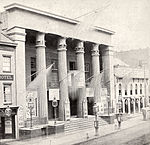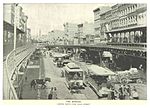Quaker Meeting-house (New York City)
1818 establishments in New York (state)Churches completed in 1818Churches in ManhattanConsolidated EdisonDemolished buildings and structures in Manhattan ... and 6 more
Demolished churches in New York CityFormer churches in New York CityLower East SideManhattan church stubsQuaker meeting houses in New York CityReligious buildings and structures in New York City
The Quaker Meeting-house on Hester and Elizabeth Streets, in the Lower East Side of Manhattan, New York City, was a meetinghouse for the Religious Society of Friends, built in 1818. Recorded in 1876 by the New York Express that it “has for a long time been the office of the New York Gas Light Company,” now Consolidated Edison. It was presumed demolished.
Excerpt from the Wikipedia article Quaker Meeting-house (New York City) (License: CC BY-SA 3.0, Authors).Quaker Meeting-house (New York City)
Hester Street, New York Manhattan
Geographical coordinates (GPS) Address Nearby Places Show on map
Geographical coordinates (GPS)
| Latitude | Longitude |
|---|---|
| N 40.7175 ° | E -73.9962 ° |
Address
Hester Street 146
10013 New York, Manhattan
New York, United States
Open on Google Maps








